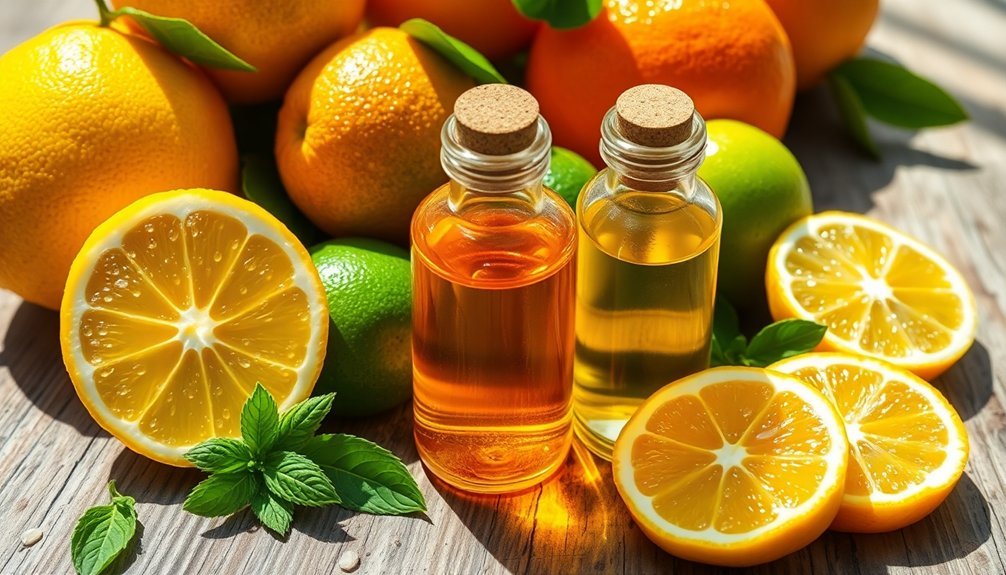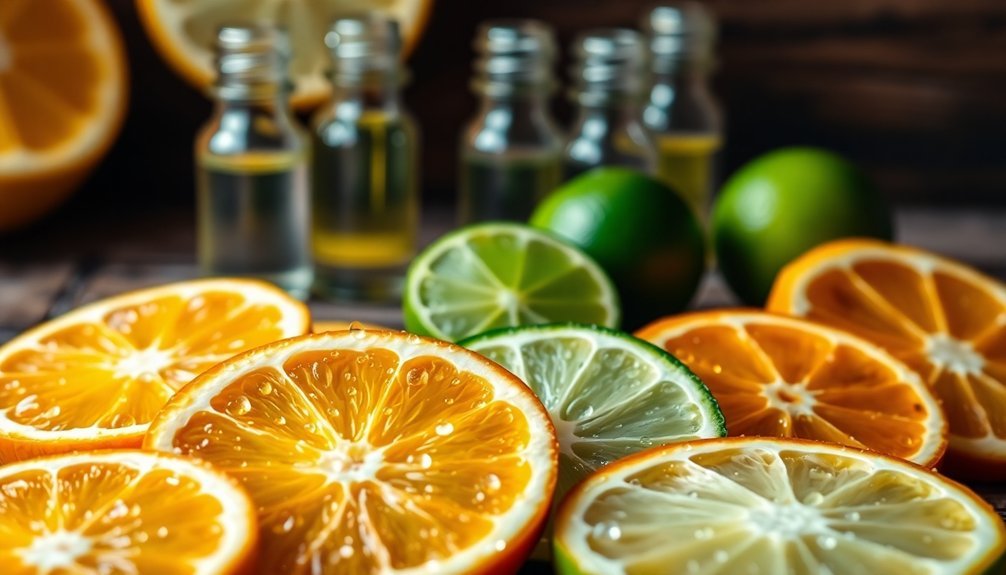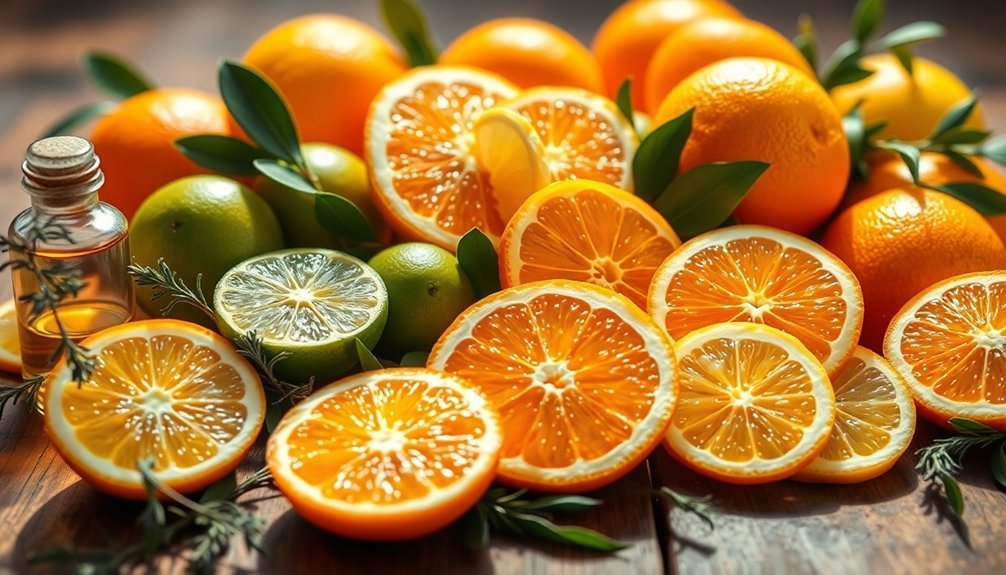Fresh citrus top notes can transform your homemade perfumes with their bright, energetic character. You'll want to start with essential oils like lemon, bergamot, or sweet orange, using 30% of your blend for these uplifting scents. For the best results, pair them with floral middle notes like jasmine or lavender, and ground them with woody base notes such as cedar or vetiver. Understanding these simple proportions will reveal endless possibilities for your signature scent creation.
Understanding The Magic Of Citrus Essential Oils

The enchanting world of citrus essential oils opens up a vibrant spectrum of aromatic possibilities.
You'll discover these precious oils are extracted from the peels of fruits like lemons, sweet oranges, and bergamot through methods such as cold-pressing and steam distillation.
What makes these oils truly special is their rich composition of limonoids and flavonoids, compounds that pack powerful antioxidant and antibacterial properties.
They're also loaded with vitamin C, making them valuable additions to your perfume-making journey.
You'll find that citrus oils aren't just about their fresh, invigorating scents – they're mood enhancers too. These oils are particularly effective at reducing anxiety and stress when incorporated into your daily aromatherapy practice.
When you're creating your perfumes, these oils serve as excellent top notes, offering that initial burst of brightness that can transform your blend while promoting feelings of happiness and relaxation.
Best Citrus Notes For Your Signature Scent
You'll discover that citrus notes can transform dramatically with the seasons, making your signature scent more versatile throughout the year.
Creating the perfect citrus-based fragrance requires understanding how to layer essential oils, from bright top notes like lemon and bergamot to more complex base notes like mandarin with woods. These combinations create a smooth olfactory blend that makes individual notes hard to identify, similar to the acclaimed Perseus Eau de Parfum.
Whether you're drawn to fresh summer combinations or warmer winter blends, mastering seasonal citrus pairings will help you craft a truly personalized scent that evolves with your lifestyle.
Seasonal Citrus Combinations Guide
Finding your perfect citrus fragrance combination depends largely on the season, as different citrus notes pair beautifully with specific complementary scents throughout the year.
For spring and summer, you'll want to explore floral and aquatic pairings. Try combining jasmine with lemon, or grapefruit with ocean-inspired notes for a fresh, invigorating effect. Research shows that citrus scents boost mood and help fight fatigue during warm weather months.
As autumn and winter approach, shift toward warmer combinations. You'll find citrus notes blend wonderfully with spices like cinnamon and cloves, creating cozy seasonal scents.
For evening wear or special occasions, consider oriental combinations that pair citrus with vanilla or precious resins. Don't overlook woody bases either – they'll help anchor your citrus notes while adding sophistication to your fragrance.
Cedar and vetiver work particularly well with lemon or lime, offering year-round versatility.
Layering Essential Citrus Notes
Creating a signature scent with citrus notes requires understanding how different citrus elements interact and complement each other. Start by selecting your primary citrus note, then layer complementary elements to build depth and longevity in your fragrance.
- Choose bergamot as your foundation for a balanced sweet-fresh profile that works well with most combinations.
- Enhance depth by pairing orange with woody notes like cedar or vetiver for lasting power.
- Add complexity with grapefruit and spicy notes like pink pepper for a modern twist.
- Layer lemon with floral heart notes such as jasmine or rose to extend the citrus presence.
- Incorporate lime with herbal elements like basil for a fresh, aromatic blend.
Remember to use high-quality essential oils and proper blending techniques to avoid common pitfalls like fleeting scents or harsh edges in your final creation.
Blending Techniques With Citrus Top Notes

You'll find that layering citrus essential oils requires careful attention to proportions, starting with your chosen citrus top note as the foundation.
When blending, use the 30-50-20 rule: 30% top notes (your citrus selections), 50% middle notes (florals or greens), and 20% base notes (woods or musks) to create a balanced composition.
Your final blend should include no more than 15-20 drops total, letting you adjust the ratios until you've achieved your desired scent profile.
Layering With Essential Oils
When blending citrus top notes in perfumery, mastering proper layering techniques secures a balanced and long-lasting fragrance.
Start by applying your chosen base citrus scent to pulse points, then add complementary citrus or green notes for complexity. Middle notes like lavender or geranium will bind your blend, while woody or musky base notes provide depth and staying power.
- Choose a primary citrus like lemon, orange, or bergamot for your foundation
- Layer complementary citrus notes or fresh herbs for added dimension
- Include middle notes such as lavender or rosemary to stabilize the blend
- Add woody or musky base notes to enhance longevity
- Experiment with different ratios to create your signature scent
Remember to use quality essential oils from trusted suppliers to guarantee the best results and minimize skin sensitivity risks.
Perfect Proportions For Citrus
The art of blending citrus top notes requires precise proportions to achieve a balanced and harmonious fragrance.
You'll want to start with citrus top notes making up 20-40% of your blend, as these volatile oils will create that initial burst of freshness.
Follow this with your middle notes, which should comprise 50-75% of the mixture to form the heart of your perfume.
For depth and longevity, include 5-10% base notes.
When you're working with citrus, try pairing it with complementary scents like florals, spices, or woody notes.
Start with small quantities and carefully track your measurements – this'll help you replicate successful blends later.
Creating Lasting Impressions With Citrus Oils
Creating lasting impressions with citrus oils requires mastering both traditional techniques and modern innovations. You'll find that citrus essential oils like bergamot, lemon, and grapefruit offer unique characteristics that can transform your perfume creations.
While citrus notes typically act as top notes, you can extend their longevity by combining them with complementary base notes.
- Use bergamot for its complex, balsamic undertones that blend beautifully with woody bases
- Incorporate yuzu or lemon myrtle for enhanced staying power
- Combine grapefruit with amber notes to create depth and persistence
- Layer multiple citrus oils to build a more sophisticated profile
- Mix citrus with floral notes to achieve a balanced, lasting composition
These strategic combinations will help you craft memorable fragrances that maintain their vibrant citrus character throughout their wear time.
Seasonal Perfume Recipes Using Citrus Notes

Seasonal shifts inspire endless possibilities for crafting unique citrus-based perfumes that capture each time of year's distinct character.
For spring, combine fresh lemons and oranges with herbs like rosemary or mint, adding jasmine for a feminine touch.
In summer, try pairing lime with coconut or bergamot with lavender for a revitalizing tropical vibe.
As autumn and winter approach, you'll want to ground your citrus notes with warmer elements.
Mix orange or lemon with cedarwood and spicy ginger, or add vanilla and amber for cozy depth.
For year-round versatility, create unisex blends using bergamot and orange with ginger, or experiment with lemon and cassis combinations.
Don't forget to adjust your ratios – you can transform any citrus blend by simply changing the proportions of your chosen ingredients.
Therapeutic Benefits Of Citrus In DIY Perfumes
Beyond their enchanting fragrances, citrus oils in DIY perfumes offer remarkable therapeutic benefits that enhance both physical and emotional well-being.
You'll experience mood elevation and stress relief through the aromatic properties of these versatile oils, particularly from compounds like limonene that help break the fight-or-flight cycle.
When you incorporate citrus oils into your perfume blends, you'll gain these key benefits:
- Improved emotional balance and mental clarity
- Enhanced immune system function through antioxidant properties
- Better skin health with natural blemish-fighting abilities
- Digestive support and comfort
- Reduced stress and anxiety through aromatherapy
Remember to dilute your citrus oils properly when creating perfumes, as this guarantees both safety and effectiveness while allowing you to harness their full therapeutic potential.
Frequently Asked Questions
Can Citrus Oils Stain Clothing When Used in Homemade Perfumes?
Yes, citrus oils can stain your clothes when they come in direct contact. You'll want to be careful as lemon, orange, and grapefruit oils contain natural dyes that'll leave marks on fabrics.
How Do Different Storage Temperatures Affect Citrus Notes' Longevity?
You'll get the best longevity by storing citrus notes in cool, dark places around 60-70°F. Avoid extreme temperatures – heat makes them evaporate quickly, while extreme cold can make them cloudy or separate.
Are Synthetic Citrus Notes More Stable Than Natural Ones?
Yes, you'll find synthetic citrus notes are considerably more stable than natural ones. They don't oxidize easily, they're less reactive to environmental factors, and they'll maintain their fresh character much longer than natural alternatives.
Which Citrus Oils Can Cause Photosensitivity When Worn Outdoors?
You'll need to be careful with cold-pressed bergamot, lemon, lime, and grapefruit oils as they can cause skin reactions in sunlight. It's safer to use their steam-distilled versions or non-phototoxic alternatives.
Does the Season When Citrus Oils Are Harvested Affect Their Scent Quality?
Yes, you'll notice seasonal variations in citrus oil scents. The timing of harvest affects the concentration of aromatic compounds, especially d-limonene. Late autumn to early spring typically yields the highest quality essential oils.
In Summary
You'll find that citrus top notes bring an energizing, uplifting quality to your homemade perfumes while offering therapeutic benefits. By mastering the art of blending these vibrant essential oils, you're able to create signature scents that reflect your personality and mood. Don't forget to experiment with different combinations and seasonal recipes – your perfect citrus-based fragrance is just a few drops away.
References
- https://us.clivechristian.com/blogs/olfactive-family/citrus-fragrance-family
- https://naturevibe.com/blogs/blogs/how-to-make-your-own-parfum
- https://creedboutique.com/blogs/creed-journal/ingredient-spotlight-citrus
- https://www.aupress.ca/app/uploads/OER-202302_Chamberlain_Dubberlboer_2023-Read-Think-Write.pdf
- https://www.australiannativeproducts.com.au/blogs/news/citrus-notes-in-perfume-a-fresh-twist-on-classic-fragrances
- https://www.aromatics.com/blogs/wellness/the-power-of-citrus-oils
- https://www.freshskin.co.uk/blog/a-complete-guide-to-citrus-essential-oils/
- https://www.lifenreflection.com/how-to-make-your-own-perfume/
- https://nikura.com/blogs/living-well/a-guide-to-citrus-essential-oils
- https://www.marieclaire.com/beauty/best-citrus-fragrances/





Leave a Reply